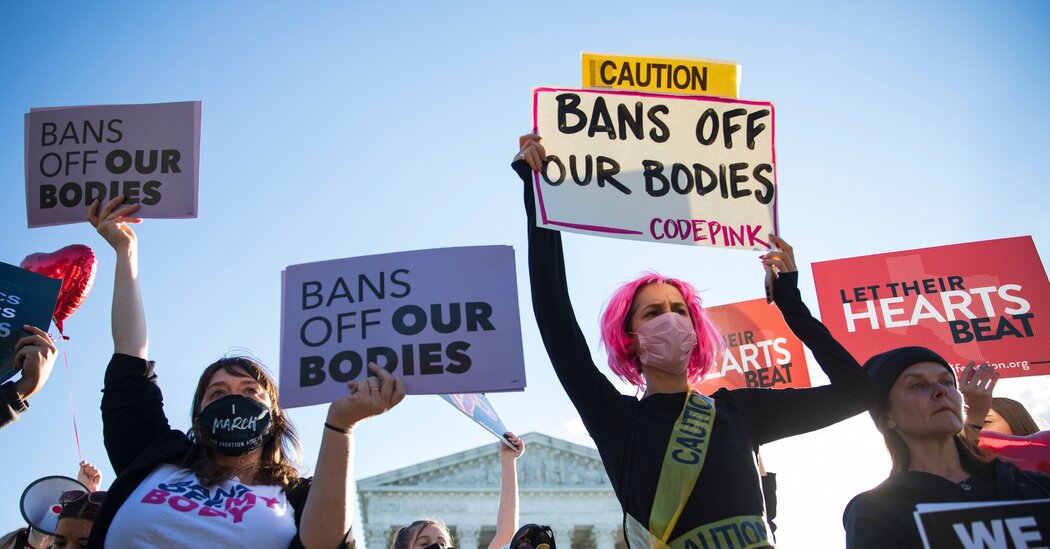
WASHINGTON — The Supreme Court ruled on Friday that abortion providers in Texas can challenge a state law banning most abortions after six weeks, allowing them to sue at least some state officials in federal court despite the procedural hurdles imposed by the law’s unusual structure.
But the Supreme Court refused to block the law in the meantime, saying that lower courts should consider the matter.
The development was both a minor victory for and a major disappointment to supporters of abortion rights. They had hoped that the justices would reverse course from a Sept. 1 ruling that had allowed the law to go into effect, causing clinics in the state to curtail performing the procedure and forcing many women seeking abortions to travel out of state.
“We will continue to seek justice in the shred of the case that the court has allowed to go forward and seek every other legal means to stop this catastrophic law,” said Nancy Northup, the president of the Center for Reproductive Rights.
The decision was fractured, and the majority endorsed only a narrow path to challenge the law. It allowed suits only against state licensing officials like the executive director of the Texas Medical Board, who are authorized to take disciplinary actions against abortion providers who violate the Texas law, known as Senate Bill 8.
The abortion providers “have plausibly alleged that S.B. 8 has already had a direct effect on their day-to-day operations,” Justice Neil M. Gorsuch wrote for eight of the nine justices. “And they have identified provisions of state law that appear to impose a duty on the licensing-official defendants to bring disciplinary actions against them if they violate S. B. 8.”
Only Justice Clarence Thomas dissented on this point.
But Chief Justice John G. Roberts Jr. and the court’s three liberal members — Justices Stephen G. Breyer, Sonia Sotomayor and Elena Kagan — wrote that this limited victory for the law’s challengers may well prove to be inadequate.
In partial dissents, they wrote that they would have allowed more comprehensive challenges, authorizing suits against the state’s attorney general and court clerks. Justice Sotomayor wrote that the court’s ruling could be evaded by a tweak to the Texas law, which generally bars state officials from enforcing it and instead deputizes private individuals to sue anyone who performs the procedure or “aids and abets” it.
Justice Sotomayor suggested that the court had given Texas lawmakers a road map to avoid review in federal court.
“The dispute is over whether states may nullify federal constitutional rights by employing schemes like the one at hand,” she wrote. “The court indicates that they can, so long as they write their laws to more thoroughly disclaim all enforcement by state officials, including licensing officials.”
In his own partial dissent, Chief Justice Roberts wrote that the Texas law was a calculated attempt to undermine the authority of the Supreme Court. The law is “contrary to this court’s decisions” including Roe, he wrote, and “has had the effect of denying the exercise of what we have held is a right protected under the federal Constitution.”
“The clear purpose and actual effect of S.B. 8 has been to nullify this court’s rulings,” he wrote, adding that “it is the role of the Supreme Court in our constitutional system that is at stake.”
Supporters of abortion rights reacted to the ruling with dismay.
“It’s stunning that the Supreme Court has essentially said that federal courts cannot stop this bounty-hunter scheme enacted to blatantly deny Texans their constitutional right to abortion,” Ms. Northup said. “The court has abandoned its duty to ensure that states do not defy its decisions.”
Justice Gorsuch stressed that the court’s ruling was tentative and limited to procedural questions.
“In this preliminary posture,” he wrote, “the ultimate merits question — whether S.B. 8 is consistent with the federal Constitution — is not before the court. Nor is the wisdom of S.B. 8 as a matter of public policy.”
Justice Gorsuch wrote that there were other ways to challenge the law beyond suing state officials in federal court, including by raising the unconstitutionality of the law as a defense in a state-court lawsuit brought under S.B. 8. He also noted that a state court judge had ruled in favor of abortion providers on Thursday.
That judge found that several procedural aspects of the law violated the state Constitution, including ones allowing people who had suffered no injury to sue and setting a minimum recovery of $10,000.
Abortion clinics in Texas welcomed the state-court ruling, but said that only a favorable decision from the Texas Supreme Court or the U.S. Supreme Court would allow them to start providing the procedure again without fear of crippling financial liability.
The decision in the Texas case came less than two weeks after the court heard a direct challenge to the right to abortion established in 1973 in Roe v. Wade, in a case about a Mississippi law that bans most abortions after 15 weeks. Roe prohibits states from banning abortion before fetal viability, the point at which fetuses can sustain life outside the womb, or about 23 to 24 weeks into a pregnancy.
The court’s six-member conservative majority seemed prepared to uphold the Mississippi law, and several justices indicated that they would vote to overrule Roe outright. A decision in the case is not expected until late June.
Understand the Supreme Court’s Momentous Term
Mississippi abortion law. The court heard arguments in a challenge to a Mississippi law that bars most abortions after 15 weeks. The case could lead to the end of Roe v. Wade, the 1973 decision that established a constitutional right to abortion.
The Texas law flouts Roe’s viability line by barring abortions once fetal cardiac activity can be detected, usually around six weeks of pregnancy.
The law was challenged by abortion providers and the Biden administration. In addition to the court’s decision in the abortion providers’s case, it also issued a brief, unsigned opinion on Friday dismissing the Justice Department’s appeal, with only Justice Sotomayor noting a dissent.
The court’s earlier encounter with the law left the justices bitterly divided along the same basic fault line as on Friday, with Chief Justice Roberts joining the court’s three more liberal members in dissent.
The majority opinion in that earlier ruling, issued just before midnight on Sept. 1, was unsigned and consisted of a single long paragraph. It said the abortion providers who had challenged the law in an emergency application had not made their case in the face of “complex and novel” procedural questions. The majority stressed that it was not ruling on the constitutionality of the Texas law and did not mean to limit “procedurally proper challenges” to it.
Each of the dissenting justices issued an opinion in that earlier ruling.
“The court’s order is stunning,” Justice Sotomayor wrote. “Presented with an application to enjoin a flagrantly unconstitutional law engineered to prohibit women from exercising their constitutional rights and evade judicial scrutiny, a majority of justices have opted to bury their heads in the sand.”
The case returned to the Supreme Court on two separate tracks. After the court rejected the providers’ request for emergency relief, the Justice Department filed its own challenge to the law, one that it said was not subject to the procedural barriers the providers had faced.
The abortion providers also returned to the court, asking the justices to use an unusual procedure — “certiorari before judgment” — to leapfrog the appeals court and decide whether they were entitled to sue.
The Supreme Court agreed to decide both cases on Oct. 22, putting then on an extraordinarily fast track. It heard arguments just 10 days later, on Nov. 1, focusing on the question of whether the providers and the government were entitled to sue in light of the law’s unusual structure.
The justices differed about whether the court had moved swiftly enough.
“The court should have put an end to this madness months ago, before S. B. 8 first went into effect,” Justice Sotomayor wrote. “It failed to do so then, and it fails again today.”
“The court’s delay in allowing this case to proceed has had catastrophic consequences for women seeking to exercise their constitutional right to an abortion in Texas,” Justice Sotomayor added.
Justice Gorsuch responded that “this case has received extraordinary solicitude at every turn.” The emergency application that gave rise to the court’s Sept. 1 order, he wrote, was resolved in days. The latest opinions, he added were issued fewer than 50 days after the court agreed to hear the case.




